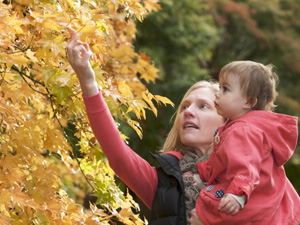Bumper autumn for forest fruits expected as nature puts on a rare show

Visitors to woods and forests are in for a spectacular show of forest fruits this autumn, with the season looking like a bumper year for the fruits and seeds of many trees and shrubs, according to the Director of the Forestry Commission’s National Arboretum at Westonbirt.
Early signs are that ash, English oak, field maple, beech, hawthorn, hornbeam and small-leaved-lime trees will produce large crops, laden with seeds, fruits and nuts, all because of one of nature’s mysterious events known as ‘masting’.
Bumper seed years are known as ‘mast years’; a natural phenomenon where some tree species produce very large crops of seeds in some years, compared to almost none in others.
It’s not known exactly why mast years occur, however they have been linked to various causes over the years, including weather and climatic conditions.
Simon Toomer, Director of the Forestry Commission’s National Arboretum at Westonbirt commented:
“Part of the fascination of experiencing a mast year is that we don’t completely understand the complex blend of factors that give rise to them and allow plants to coordinate the production of so much fruit and seed.
“Weather and climate can certainly affect fruit and seed production in plants, however we also see certain trees go through cycles of mast years. Beech for example produces a mast year every five to 10 years.”
With such an abundance of food available, seed-eating animals and birds, such as grey squirrels and jays, are expected to take advantage of the bounty to hoard supplies for later in the winter.
Seed-eating animal populations drop during non-mast years. As a result, in a mast year there are far more seeds than the population of predators can eat. This in turn means that more seeds will survive to next spring and germinate.
With so much food available, wildlife that feed on forest fruits are more likely to survive the winter in comparison to non-mast years and breed the following spring, indicating that the populations of seed-eating wildlife are likely to peak next summer.
Matthew Parratt, a scientist at Forest Research, the research agency of the Forestry Commission, said:
“This year our forests, woodlands and back gardens will put on quite a show with a number of our trees producing abundant levels of fruit and nuts.
“During non-mast years fruits, seeds and nuts are still produced, but not in these quantities, so it really will be a strong year for our harvest and wildlife.
“This occurrence is a great opportunity to experience nature at its best and with so much food you’re likely to spot more wildlife around the trees, so it’s a prime time to get out with the family and explore our woodland.”
The Forestry Commission has produced a spotter’s guide to trees and their fruits this autumn to help their woodland visitors identify fruits and seeds. Events, fungi forays and guided walks are just some of the autumn events visitors can also join in with this season.
For the fruit spotter’s guide and information about events and exploring Forestry Commission managed woods and forests this autumn, visit www.forestry.gov.uk/autumn.
Explore Gloucestershire
26 September 2013
For further information.
OTHER NEWS
- Christmas presents with a difference at Cotswold Wildlife Park
- Stunning sculpture of Rhino mother and baby takes centre stage
- Air Tattoo on Friday? Take it as Red
- Christmas parade to light up Cheltenham this Saturday
- Dean Heritage centre closes to prepare for Christmas
- The Wilson welcomes 25,000 visitors in its first month
- News from Cheltenham Fashion Week
- Birds of Gloucestershire at Nature in Art
- A taste of Italy comes to Tewkesbury
- Remembrance Day ceremony at council offices, Tewkesbury
- REVIEW: Seven Brides For Seven Brothers
- Cottage of the Week: The Lodge, Lydney
- REVIEW: The Complete Works of William Shakespeare (Abridged) {Revised}
- Local artist Mariette Voke paints the past and draws the future
- Cottage of the Week: Swallow’s Nest, Lower Mill Estate, Cirencester
- Bonfire Nights & Fireworks Displays in Gloucestershire 2013
- Complete Guide to Christmas in Gloucestershire 2013
- Sudeley Castle features on Channel 4’s River Cottage to the Core
- Animals show off their wild side for Halloween
- ALADDIN: The Everyman’s Traditional Pantomime is Back!
- Cottage of the week: Capp Mill, Painswick
- Halloween Flights of Fancy at Birdland
- Cottage of the Week: Dawn Run, Winchcombe
- Cracking Season at the Lido
- Cottage of the Week: The Old Farmhouse, Blakeney
- The top 10 things to do at Westonbirt Arboretum this autumn!
- Winter Woodland Break Offer at Whitemead Forest Park
- Halloween Events & October School Holidays in Gloucestershire
- 2013 Christmas Guide to Gloucestershire out soon!
- Brand New Website!
- Re-opening of Cheltenham Art Gallery & Museum
- Bumper autumn for forest fruits expected as nature puts on a rare show
- Get ready for Christmas at Beechenhurst in the Heart of the Forest
- Cottage of the week: Emma’s Cottage, Chedworth, Nr. Cirencester
